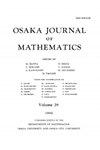“幂零李群的Beurling定理”一文的勘误,大阪J.数学,48(2011),127—147
IF 0.5
4区 数学
Q3 MATHEMATICS
引用次数: 0
摘要
这里W是g中一般伴随轨道s的合适截面,g的向量空间对偶。这个定理的条件(1.1)取决于G中x的范数所定义的基的选择。在陈述定理1.3之前,我们必须先定义G中x的范数。为此我们必须确定g的基底,然后用这个基底定义x的模。此外,在定理1.3的证明过程中,我们不应该修改这个基t。这意味着,论文中2.5.1的注释是不正确的。本文章由计算机程序翻译,如有差异,请以英文原文为准。
Erratum to the article ``Beurling's theorem for nilpotent Lie groups'' Osaka J. Math. 48 (2011), 127--147
Here W is a suitable cross-section for the generic coadjoint orbit s in g , the vector space dual ofg. The condition (1.1) of this theorem depends on the choice of t he bases for which the norm of x in G is defined. We must define the norm of x in G before stating Theorem 1.3. For this we must fix a bases of g, and then define the norm of x using this bases. In addition, we shouldn’t modify this bases t hroughout the proof of Theorem 1.3. This implies that, Remark 2.5.1 in the paper is n ot correct.
求助全文
通过发布文献求助,成功后即可免费获取论文全文。
去求助
来源期刊
CiteScore
0.90
自引率
0.00%
发文量
0
审稿时长
>12 weeks
期刊介绍:
Osaka Journal of Mathematics is published quarterly by the joint editorship of the Department of Mathematics, Graduate School of Science, Osaka University, and the Department of Mathematics, Faculty of Science, Osaka City University and the Department of Pure and Applied Mathematics, Graduate School of Information Science and Technology, Osaka University with the cooperation of the Department of Mathematical Sciences, Faculty of Engineering Science, Osaka University. The Journal is devoted entirely to the publication of original works in pure and applied mathematics.

 求助内容:
求助内容: 应助结果提醒方式:
应助结果提醒方式:


